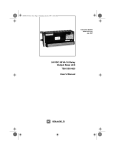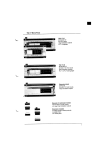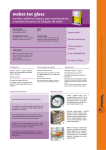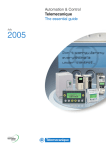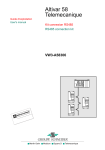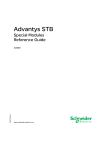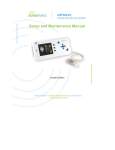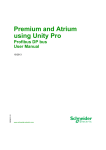Download 16 Input 120 VAC Base Unit User`s Manual
Transcript
30598-381-01B1 Text Page 1 Saturday, July 26, 1997 10:01 AM Instruction Bulletin 30598-381-01B1 July 1997 16 Input 120 VAC Base Unit TBX DES16S04 User’s Manual 30598-381-01B1 Text Page 2 Saturday, July 26, 1997 10:01 AM WARNING UNINTENTIONAL EQUIPMENT OPERATION To avoid improper handling of equipment: The application of this product requires expertise in the design and programming of control systems. Only persons with such expertise should be allowed to program, install, alter, and apply this product. Failure to observe this instruction can result in death or serious injury. CAUTION EQUIPMENT DAMAGE HAZARD To avoid improper handling of equipment: 1. Never remove this device while power is ON. 2. Do not subject to static discharge. This module contains electronic components that are very susceptible to damage from electrostatic discharge. Failure to observe this instruction can result in equipment damage. SY/MAX, SY/NET, SY/LINK, and SY/MATE are registered trademarks of Square D Company. PASSPORT and IO/NET are trademarks of Square D Company. © 1997 Schneider S.A. All rights reserved. This document may not be copied in whole or in part, or transferred to any other media, without the written permission of Schneider S.A. Electrical equipment should be serviced only by qualified electrical maintenance personnel. No responsibility is assumed by Schneider S.A. for any consequences arising out of the use of this material. 30598-381-01B1 Text Page 3 Saturday, July 26, 1997 10:01 AM Bulletin No. 30598-381-01B1 July 1997 16 Input 120 VAC Base Unit TBX DES16S04 DESCRIPTION The TBX DES16S04 is a distributed input base unit containing sixteen 120 VAC digital inputs. This base unit may be coupled with a compatible communications interface to form a complete distributed block, which is well suited for the control of discrete field devices located some distance from a host programmable logic controller (PLC). The application of distributed I/O blocks saves installation and maintenance cost, as compared to direct wiring of field devices to a centralized I/O system over long distances. The TBX DES16S04 base unit can be used with either SY/MAX® or Telemecanique PLCs, through the use of a compatible communications interface, or “top hat”. The interface mounts directly on the base unit, and allows the PLC to read and write to the I/O points through a suitable control network. The Class 8030 Type CRM275 Distributed Remote IO/NET™ Interface (DRIO) supports connection to the IO/NET control network as part of the PASSPORT™ I/O System. The TBX LEP020 and TBX LEP030 communications interfaces support connection to the FIPIO network. The TBX CBS010 Expansion Interface allows connection of a second TBX base unit to a single communications top hat. The DES16S04 base unit supports the following TBX I/O features: • Sixteen input points - Suitable for use with discrete field devices such as solenoids, contactors and pilot lights. • Input power loss indication - Reports back to the processor if the output power supply drops below the valid level. • Input fallback state control - Point-by-point control over output states when communication is lost. • Removable field wiring terminal strip - Mounts securely to the base unit without use of screws or fasteners. This bulletin contains information on installation and application of the TBX DES16S04 base unit with either SY/MAX or Telemecanique PLCs. For information about programming a SY/MAX PLC for use with the TBX DES16S04 base, refer to the Class 8030 Type CRM275 (DRIO) instruction bulletin (#30598-380). For information about programming a Telemecanique PLC for use with the TBX DES16S04 base, refer to the Telemecanique TBX Distributed I/O Modules manual (TSX DM TBX V5E). Please read and keep all the appropriate manuals close at hand when using TBX base units. Top hats receive +24 VDC from the primary base, which the top hat converts to logic power for the top hat and bases. For additional information on the DRIO Interface and the Expansion Interface, refer to instruction bulletins 30598-380 and 30598-371 respectively. The TBX SUP10 power supply may be used to provide 24 VDC for TBX bases and sensors from an AC source. © 1997 Schneider S.A. All Rights Reserved 3 30598-381-01B1 Text Page 4 Saturday, July 26, 1997 10:01 AM 16 Input 120 VAC Base Unit TBX DES16S04 Bulletin No. 30598-381-01B1 July 1997 SPECIFICATIONS Base Unit Power Operating voltage: 120 VAC Operating current at nominal voltage: Configuration Nominal Base only 30 mA Base with comms interface 100 mA Base, interface and expansion base 125 mA Inputs Inputs per base unit Number of input commons Isolation rating Voltage operating range Maximum output current Maximum voltage drop OFF state leakage current Maximum turn ON time Maximum turn OFF time I/O status indication 16 1 1500 V rms between outputs and earth terminal 24 VDC nominal; 19-30 VDC 0.5 A 0.4 V < 2 mA 1 ms 1 ms Visual indication provided by communications interface: 1 LED per input point Environmental and Physical Operating temperature rating Storage temperature rating Humidity rating Dimensions (H x W x D): Base unit w/ terminal strip Base w/ comms. interface or Base w/ CBS010 Interface Weight (Base unit only) 4 0 to 60°C (32 to 140°F) -40 to 80°C (-40 to 176°F) 5-95% RH, non-condensing See Figure 1 3.43 x 9.25 x 2.4 in (87 x 235 x 61 mm) 3.43 x 9.25 x 2.91 in (87 x 235 x 73.9 mm) 1.3 lb (0.6 kg) © 1997 Schneider S.A. All Rights Reserved 30598-381-01B1 Text Page 5 Saturday, July 26, 1997 10:01 AM Bulletin No. 30598-381-01B1 July 1997 16 Input 120 VAC Base Unit TBX DES16S04 Agency Compliance 0.24 6.1 Complies with UL508, CSA C22-2 requirements, and FM Class I, Division 2 Hazardous Locations approval requirements 3.43 87 2.13 54 1.30 33 0.22 5.6 DIN Rail Center Line 40 Position I/O Terminal Strip 8.27 210 9.25 235 in Dimensions: mm 61 2.4 Top view with DIN rail mounting dimensions 40.6 1.6 8.74 222 Side view Figure 1: Dimensions BASE UNIT WIRING Input devices are wired to the terminal strip on the top of the base unit. Figure 2 shows the terminal strip pin-out for the base unit. Two terminal strip labels are packaged with the base unit. If you are using the base unit with a SY/MAX system, use the terminal strip label with I/O numbered from 1-16; if you have a Telemecanique system, use the terminal strip label with I/O numbered from 0-15. These are both illustrated in Figure 2. The TBX DES16S04 provides separate terminals for base voltage and control output voltage. These terminals may be connected to a common 120 VAC supply or may be sourced by independent supplies (terminals 1 and 4 must be at the same potential). WARNING INCORRECT WIRING The base must be properly grounded before applying power. Equipment MUST be grounded using the screw provided. Do not use metallic conduit as a ground conductor. Failure to observe these instructions can result in death or serious injury. © 1997 Schneider S.A. All Rights Reserved 5 30598-381-01B1 Text Page 6 Saturday, July 26, 1997 10:01 AM 16 Input 120 VAC Base Unit TBX DES16S04 Bulletin No. 30598-381-01B1 July 1997 Base voltage 120 VAC 3 1 2 4 9 7 5 6 11 10 8 13 12 15 17 16 14 21 19 18 20 23 22 25 24 27 26 29 28 31 30 33 32 35 34 37 39 36 38 40 Input control voltage 120 VAC L2 L1 COM IN-L1 I0 I1 I2 I3 I4 I5 I6 I7 I8 I9 I10 I11 I12 I13 I14 I15 5 7 9 11 13 15 17 19 21 23 25 27 29 31 33 35 37 39 3 1 2 4 6 10 8 12 16 14 18 20 22 24 26 28 30 32 34 36 NC 38 40 Telemecanique labels (0-15) GND IN-L2 COM COM COM COM COM COM COM COM COM COM COM COM COM COM COM COM NC GND ININININININININININININININININL1 L1 L1 L1 L1 L1 L1 L1 L1 L1 L1 L1 L1 L1 L1 L1 L2 L1 COM IN-L1 I1 I2 I3 I4 I5 I6 I7 I8 I9 I10 I11 I12 I13 I14 I15 I16 1 3 5 7 9 11 13 15 17 19 21 23 25 27 29 31 33 35 37 39 2 4 6 8 10 12 14 16 18 20 22 24 26 28 30 32 34 36 NC 38 40 SY/MAX labels (1-16) GND IN-L2 COM COM COM COM COM COM COM COM COM COM COM COM COM COM COM COM NC GND ININININININININININININININININL1 L1 L1 L1 L1 L1 L1 L1 L1 L1 L1 L1 L1 L1 L1 L1 Figure 2: TBX DES16S04 Wiring Connections & Terminal Block Signal Assignments WARNING UNINTENTIONAL EQUIPMENT OPERATION Be sure to use the appropriate SY/MAX or Telemecanique terminal strip label when wiring inputs or outputs. Two terminal strip labels are packaged with the base unit. If you are using the base unit with a SY/MAX system, use the terminal strip label with I/O numbered from 1-16; if you have a Telemecanique system, use the terminal strip label with I/O numbered from 0-15. Failure to observe these instructions can result in death, serious injury, or equipment damage. 6 © 1997 Schneider S.A. All Rights Reserved 30598-381-01B1 Text Page 7 Saturday, July 26, 1997 10:01 AM Bulletin No. 30598-381-01B1 July 1997 16 Input 120 VAC Base Unit TBX DES16S04 MOUNTING INSTRUCTIONS The base unit can be mounted horizontally or vertically as shown in Figure 3. ① Mounting horizontally side-by-side ① Mounting vertically side-by-side (terminal strips must be toward right as shown) ① ① Spacing: 1 in (25 mm) Mounting horizontally Figure 3: Base Unit Orientation Examples To mount the base unit on a 35-mm DIN rail: 1. Hook the base unit onto the rail as shown in Figure 4. 2. Press down and toward the DIN rail until the base unit is secure. (There are two spring clips in the top of the groove on the back of the unit.) To remove the base unit from a DIN rail: 1. Press down on the base unit. 2. Swing the unit outward and lift it off the rail at the same time as pressing down. NOTE: If the base unit is to be used in a high-vibration environment, mounting the unit on a panel rather than a DIN rail provides more stability. Use cable ties to secure the communication cable. 2 1 Figure 4: Mounting and Removing the Base Unit © 1997 Schneider S.A. All Rights Reserved 7 30598-381-01B1 Text Page 8 Saturday, July 26, 1997 10:01 AM INSTALLATION AND APPLICATION CONSIDERATIONS NOTE: The base unit is not compatible with the Type CRM270 module. • Base Voltage - The DES16S04 base requires a 120 VAC operating voltage to be applied between VB+ and VB- (terminals 3 and 1, respectively). • Grounding - The green ground wire must be connected to the ground screw beside the terminal block. • Jumper Wire - A #16 AWG wire must be installed between terminals 2 and 40. • Commons - The DES16S04 base unit has one common terminal for every input. • Fusing - The base and control power lines must be externally fused by the user. • External Wiring - Each terminal accommodates up to two #16 AWG gauge wires. • Noise Suppression - The DES16S04 base unit has internal transient noise suppression. Therefore, outputs may be wired in series or parallel with hard contact switches to control an inductive load (such as a motor starter to a solenoid). • Voltage Sensing - The TBX DES16S04 base unit monitors and reports the status of the inputs’ power supply. (The status of this voltage is indicated in bit 2 of SY/MAX register S0003. See “Register Usage with SY/MAX Class 8030 Type CRM275 DRIO”.) • Freeze State Control - TBX Distributed I/O feature an enhancement to the Freeze Outputs capability of the IO/NET control network. In the default configuration, when the IO/NET Freeze bit is set and if communication between the LIO and DRIO fails, the DRIO maintain the outputs in their last state before the communication failure. This operation is the same as the Freeze State for the RIO (Type CRM260). With TBX Distributed I/O, the user may also have the DRIO set the outputs to a pre-defined state. By defining the output fallback states in register S0006 and setting the Freeze State control bits in S0004 to the fallback option, the DRIO sets the outputs to the fallback state when a Freeze condition occurs. When communications are restored, the outputs will return to normal operation. REGISTER USAGE WITH THE SY/MAX CLASS 8030 TYPE CRM275 DRIO MODULE The DES16S04 base unit supports the assignment of 10 registers for I/O, diagnostic and configuration registers. Additional information about base unit register usage is contained in the DRIO instruction bulletin (#30598-380). This base unit supports I/O power loss indication (Register 3), output fallback state control (Register 4, bits 5-6; Register 6), input pulse latching (Register 4, bits 7-10; Register 9) and wiring fault check (Register 7, bits 1-16). Refer to Chapter 4 of the DRIO instruction bulletin for more information about register assignments. WARNING UNINTENTIONAL EQUIPMENT OPERATION Do not use reserved registers and bits in PLC programs. Erratic operation may result. Failure to observe this instruction can result in death, serious injury, or equipment damage. Merlin Gerin 30598-381-01B1 Square D July 1997 Telemecanique Printed in USA © 1997 Square D All Rights Reserved DLC








